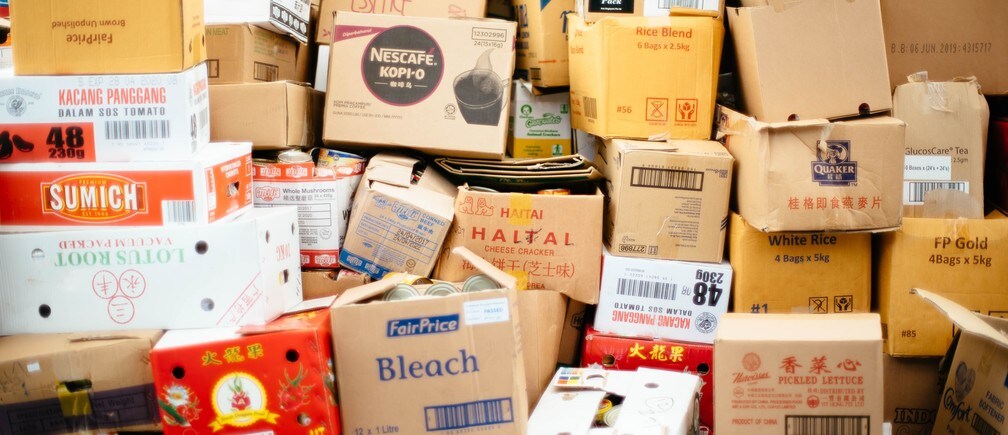Online shopping is polluting the planet - but it's not too late

Is there a way to make online shopping more climate conscious? Image: Unsplash/chuttersnap

Get involved with our crowdsourced digital platform to deliver impact at scale
Stay up to date:
Climate Change
- Demand for urban last-mile delivery is expected to grow 78% by 2030, leading to 36% more delivery vehicles in 100 cities around the world.
- Deliveries will cause related emissions to rise by nearly one-third and add 11 minutes to each passenger’s commute.
- A new report analyses possible interventions including droids, electric vehicles and parcel lockers.
A growing consumer appetite for convenience – getting anything you want delivered to your front door by tomorrow in just one click – is taking its toll on the environment.
To meet this demand, there could be 36% more e-commerce delivery vehicles driving around inner cities by the end of the decade – meaning more emissions, pollution and congestion.
By 2030, urban last-mile delivery emissions – which are from the final leg of the journey to get a product to the consumer – are set to increase by more than 30% in 100 cities globally, according to a new study by the World Economic Forum.
Not only that, but commutes could increase by 21%, taking up to 11 minutes longer due to the extra traffic on the road.

But it's not all bad news. The Future of the Last-Mile Ecosystem has identified 24 fixes, from automated robots to hydrogen electric vehicles, that would reduce the impact of e-commerce deliveries on cities and the planet.
“Rising congestion and emissions from e-commerce delivery are already putting stress on city traffic patterns and this pressure will only rise from growing demand unless effective intervention is quickly taken by both cities and companies,” says Christoph Wolff, Head of Mobility, World Economic Forum.
From 2014-2019, e-commerce sales ratios nearly tripled globally, according to the report.
By 2030, the demand for last-mile delivery is expected to grow 78% with online stores, e-grocers and food delivery services competing to offer faster home deliveries.
This trend is being fuelled by growing urbanization – with 60% of people expected to be living in cities by 2030.
Other factors causing the growth of the one-click shopping culture include the rising purchasing power of the middle class, a growing customer base worldwide, a widening range of products available online, the emergence of new digital business models and technological advancements in the delivery segments allowing for instant and time-definite delivery.
Same-day and instant delivery are the fastest-growing segments in the last-mile environment, growing 36% and 17% annually, respectively. Amazon, for example, already delivers to 72% of all customers within 24 hours.
In China, same-day and instant delivery already make up more than 10% of overall parcel deliveries – roughly 3 million daily, same-day items. This is double the number of Europe, where same-day delivery accounts for only 5% of deliveries.
Together with McKinsey & Company and the World Business Council for Sustainable Development, the Forum developed three "transition scenarios" based on 24 supply chain and technology "interventions."
The scenarios, shown below, offer insights into how to solve inner-city delivery challenges and lower CO2 emissions without affecting profit. Possible and existing solutions include everything from night-time deliveries to reduce congestion by 15%, to customer collection from lockers.

But the best-case scenario, to address these challenges and help the 3ps – people, planet and profit – is taking the multiplayer ecosystem approach, where all stakeholders work together.
“The ‘last mile’ is a complex, interwoven topic as it involves many ecosystem stakeholders,” says Bernd Heid, Senior Partner, McKinsey & Company.
"Our research shows that in an 'ecosystem scenario' in which both public and private players work together effectively, delivery emissions and congestions could be reduced by 30% until 2030 when compared to a 'do nothing' scenario, and technology can help to bring delivery costs down by 25% at the same time.”
Don't miss any update on this topic
Create a free account and access your personalized content collection with our latest publications and analyses.
License and Republishing
World Economic Forum articles may be republished in accordance with the Creative Commons Attribution-NonCommercial-NoDerivatives 4.0 International Public License, and in accordance with our Terms of Use.
The views expressed in this article are those of the author alone and not the World Economic Forum.
Related topics:
The Agenda Weekly
A weekly update of the most important issues driving the global agenda
You can unsubscribe at any time using the link in our emails. For more details, review our privacy policy.
More on Climate ChangeSee all
Babajide Oluwase
April 15, 2024
Victoria Masterson
April 12, 2024
Victoria Masterson
April 11, 2024
Lindsey Ricker and Hanh Nguyen
April 11, 2024
Daisy Dunne
April 10, 2024








